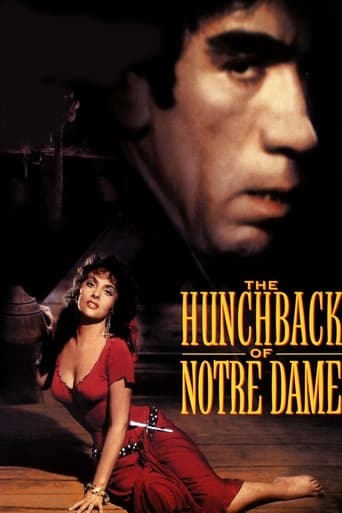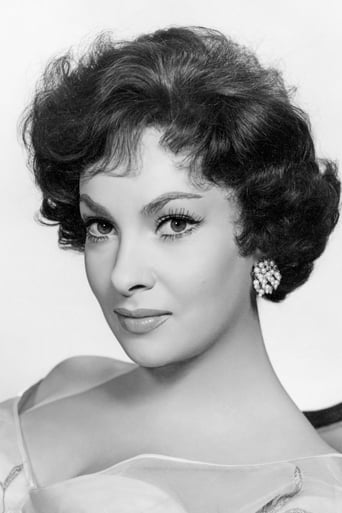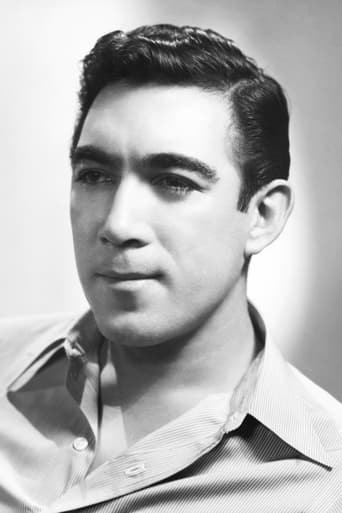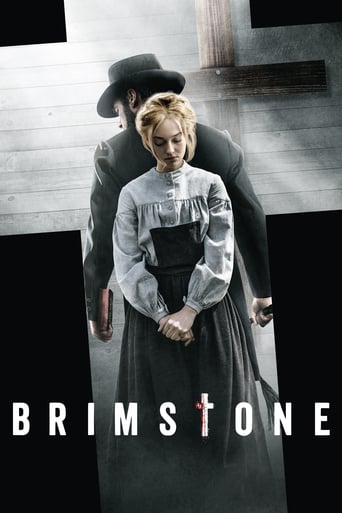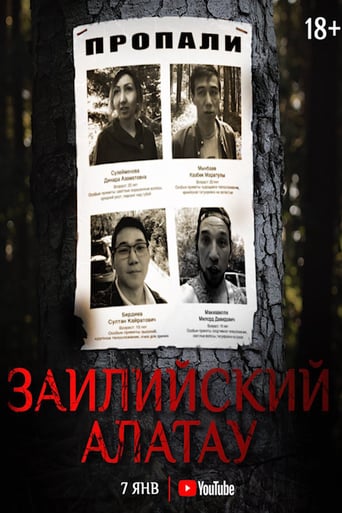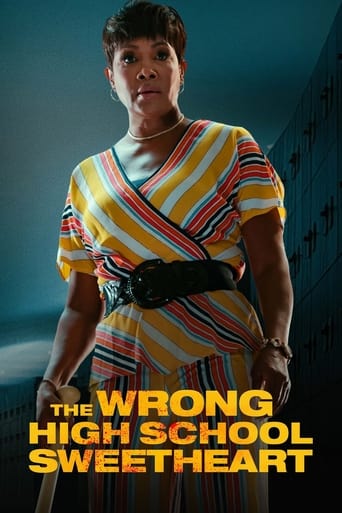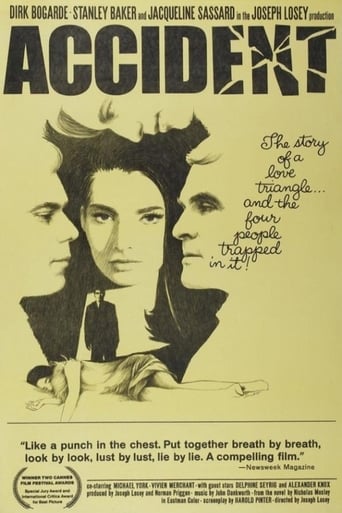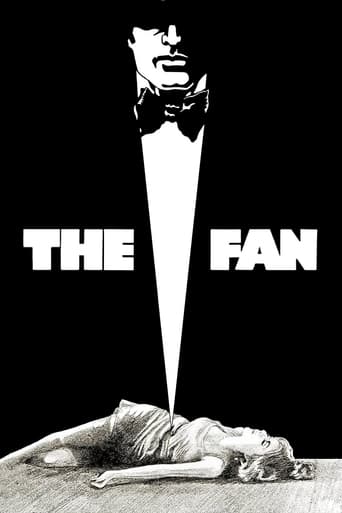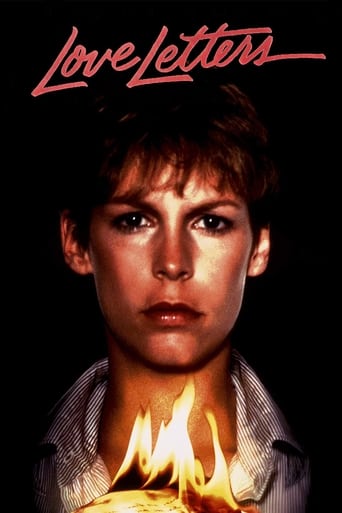The Hunchback of Notre Dame (1957)
Paris, 1482. Today is the festival of the fools, taking place like each year in the square outside Cathedral Notre Dame. Among jugglers and other entertainers, Esmeralda, a sensuous gypsy, performs a bewitching dance in front of delighted spectators. From up in a tower of the cathedral, Frollo, an alchemist, gazes at her lustfully. Later in the night, Frollo orders Quasimodo, the deformed bell ringer and his faithful servant, to kidnap Esmeralda. But when the ugly freak comes close to her is touched by the young woman's beauty...
Watch Trailer
Cast


Similar titles
Reviews
Surprisingly incoherent and boring
Powerful
It's a feast for the eyes. But what really makes this dramedy work is the acting.
This movie feels like it was made purely to piss off people who want good shows
This is a movie that has all the trappings of an epic, but isn't. But it is still a credible rendition of the Victor Hugo classic, with Gina Lollobrigida giving a strong performance as Esmeralda. The weak part of the movie is Anthony Quinn's performance as Quasimodo. Mr. Quinn's portrayal is not believable. Quasimodo is supposed to generate feelings of pathos; that does not happen in this movie. As a result, the plot becomes flat. The intensity of the relationship between Quasimodo and Esmeralda is lacking. Between Mr. Quinn's mumbling of his lines, and the treatment of the poet Gringoire as a buffoon, the movie teeters on the brink of cinematic collapse. Yet, it is saved by staying faithful to the original story and by good performances by some of the supporting cast, as well as by the essential power of the original story. The story of the hunchback and the gypsy girl is classic; read the book.
The Hunchback of Notre Dame is a very hard film to make. Mostly due to the darkness and despair of the original work. If you've only grown up with the Disney version, prepare to be shocked. I truly liked this effort, as it got a lot of the complexities of each character down. Frollo is a man of religion but also science. His faith and logical mind battling it out as he experiences lust. Esmerelda is a victim of her own beauty, but also plays a hand in her own downfall. She doesn't understand her power over men which leads to her angering of the males. Quasimodo is portrayed as not so much an outcast here. He is known by all, but is awkward and unaware of his strength. This is a film where everyone is guilty for their actions, which also makes them all sympathetic. The design of the film is often too much. WIth so many colors and such production put in it comes across as an over the top school production. Less can be more, but with the final heart wrenching scene, you'll probably be left as an emotional wreck.
The opening of this film – relating the finding of the word 'Ananké' (which the English-language narrator irritatingly mispronounces as 'Anankh'!) on the wall of the cathedral – signals that Jean Delannoy has given us the best cinema version of 'Notre Dame de Paris' yet. It is the closest in spirit to the book in picaresque colour and in its final tragedies. *Some spoilers follow, comparing the book and the film, and touching upon other film adaptations.* While international distribution (especially in the US) meant that Delannoy still had to fudge Claude's priesthood (being addressed as "Maître/Master Frollo"), his sober dress and the fact he works in Notre Dame make it implicit – indeed, obvious to anyone familiar with the book, as French audiences are. His younger brother Jehan is thus restored to his (im)proper and impish self as a wastrel student (Maurice Sarfati), who first appears dressed as an imp for the Feast of Fools. (In the 1923 and 1939 versions, Jehan became a middle-aged substitute for his brother in his relationship with Esméralda.) There are, nevertheless, differences between the French and English versions. Because of the Hays Code, Quasimodo is made *King* of Fools, *not* Pope, in the English dub, the scene being shot with two different crowns. The French version also includes scenes with Pierre after Esméralda's arrest, and an extended scene of Claude's breakdown, returning to La Falourdel's, corresponding to the book's chapter 'Fièvre' – presumably cut because the English title overemphasises Quasimodo.Anthony Quinn and Gina Lollobrigida have top billing, but Alain Cuny quietly dominates the film – as he should. Claude, not Quasimodo, is the most interesting central character: the brilliant, tormented scholar and scientist as Romantic tragic hero/anti-hero. Although over a decade too old for the role, Cuny has the right air of anguished intensity and self-destructive passion. Even as he brings suffering on others, he himself suffers still more deeply, all haunted eyes and strong cheekbones. (An acquaintance observed his hairstyle is too 1950s, but the anachronism is less significant than the fact he has so much hair at all: book-Claude's hair has receded into his tonsure!) This is the only film version that shows his alchemical researches, and sets Louis XI's incognito visit, as 'Compère Tourangeau', in his laboratory, rather than in his rooms in the cloisters. This atmospheric scene captivated me when I first saw the film on TV as a child, and as a teenager I fell in love with Claude in the book (recognising a fellow-Aspie). My chief regret is that (as usual) the passionate confrontation in prison from 'Lasciate Ogni Speranza' is omitted: this Claude is certainly handsome enough for some chest-baring cassock-ripping He gives us the film's most memorable moments: his rapt face framed by the broken window of the Grande Salle of the Palais de Justice, while in the adjacent pane we see the reflection of what grips his attention – Esméralda dancing; how he intones her name over his experiments (which reminds me of Ezra Pound's marvellous 'The Alchemist: Chant for the Transmutation of Metals': "Midonz, gift of the God, gift of the light,/gift of the amber of the sun,/Give light to the metal"); his torment at La Falourdel's, watching Phoebus (Jean Danet, suitably smug and flashy) seduce Esméralda; scratching 'Ananké' on the wall, watched by an uncomprehending Quasimodo; returning to the cathedral by moonlight, and crossing himself (cut from the English-language dub) when he sees Esméralda in ghostly white. In his last moments, he stretches out his arms, crucified by his forbidden desires, before falling. It is a superb performance, unshowy, but emotionally wrenching.Gina Lollobrigida is somewhat mature and overtly sexy to be entirely convincing as a virginal teenager, but she has glamour, vitality, and (with choreography by Myasin/Massine) dances better than most screen Esméraldas. It is believable that an otherwise ascetic and intellectual priest could be driven to crime and madness for such a beauty. Of course, with such a bright and spirited Esméralda, the question remains as to how she can be so stupid as to fall for Phoebus's smarmy charms, but that is part of the tragedy of the book – and, indeed, such calamities happen in life. Her comic relationship with Pierre Gringoire (Robert Hirsch) is delightful, with a very cute Djali as the third party in their 'marriage'. It is wonderful to see so much of Pierre, without him being rewritten as a conventional romantic lead (as in 1939 and 1982). Clopin is played somewhat younger than usual by Philippe Clay: Villon-esque, a figure from Bosch or Breughel. Quinn is the best film Quasimodo: alarming and touching by turns, unsentimentalised, and believable. Unlike Chaney or Laughton, whose deformities were far too exaggerated, he looks as if he could have survived childhood in 15C. He is deaf, and seems to have learning disabilities, as the book implies. Fleur-de-Lys (Danielle Dumont) and her friends, in their henins and colourful gowns, look as if they could have stepped out of an illuminated manuscript. Phoebus is as obnoxious and shallow as written: only in the English dub is he softened slightly by being made to regret that he could not have saved Esméralda himself.The last part of the story is truncated because of the running-time, hence the change in the events at the Bastille, and in the circumstances of Esméralda and Clopin's deaths. However, it is still far more effective than the bowdlerised 'happier' endings imposed by the 1923, 1939, 1982, 1996 and 1997 versions. The conclusion at Montfaucon is retained, and is movingly portrayed. All in all, this is a thoroughly enjoyable film, which gives a better impression of the novel than any other cinema adaptation to date, and confirms my belief that French literature usually fares best in the hands of French film-makers.
In this third version of The Hunchback of Notre Dame we get a story far closer to the truth of Victor Hugo's classic novel. Unlike the productions done starring Lon Chaney and Charles Laughton, this one was done in France by the French who took pains to remain faithful to the version Victor Hugo wrote. Note the title in the original French and note it's the cathedral not the hunchback who is the center of the story. That allowed Italian film star Gina Lollobrigida to be billed first and then Anthony Quinn as the hunchback. No doubt about it Lollobrigida is the sexiest Esmerelda going, she makes both Patsy Ruth Miller and Maureen O'Hara look like nuns. Then again she was who the movie going public was paying to see.This is not to take anything away from Anthony Quinn who seems to extend his role as the brutish strong man in La Strada into his portrayal of Quasimodo. Although Charles Laughton's performance is my favorite, this does not denigrate Quinn in any way. The rest of the cast is made up of players from the French cinema. I particularly liked Jean Tissier as the 'Spider King' Louis XI. It's a subtle piece of acting and you can see why this was no man to trifle with.The Hunchback of Notre Dame is a tale of innocence. Quasimodo's to be sure, but even the sexy and voluptuous Esmerelda. She may know all about sex, but she's pretty ignorant in the ways of the political world. Both protagonists are used by forces and people they cannot comprehend.This version of the Victor Hugo classic has its supporters and they should support this great retelling of a classic tale.

